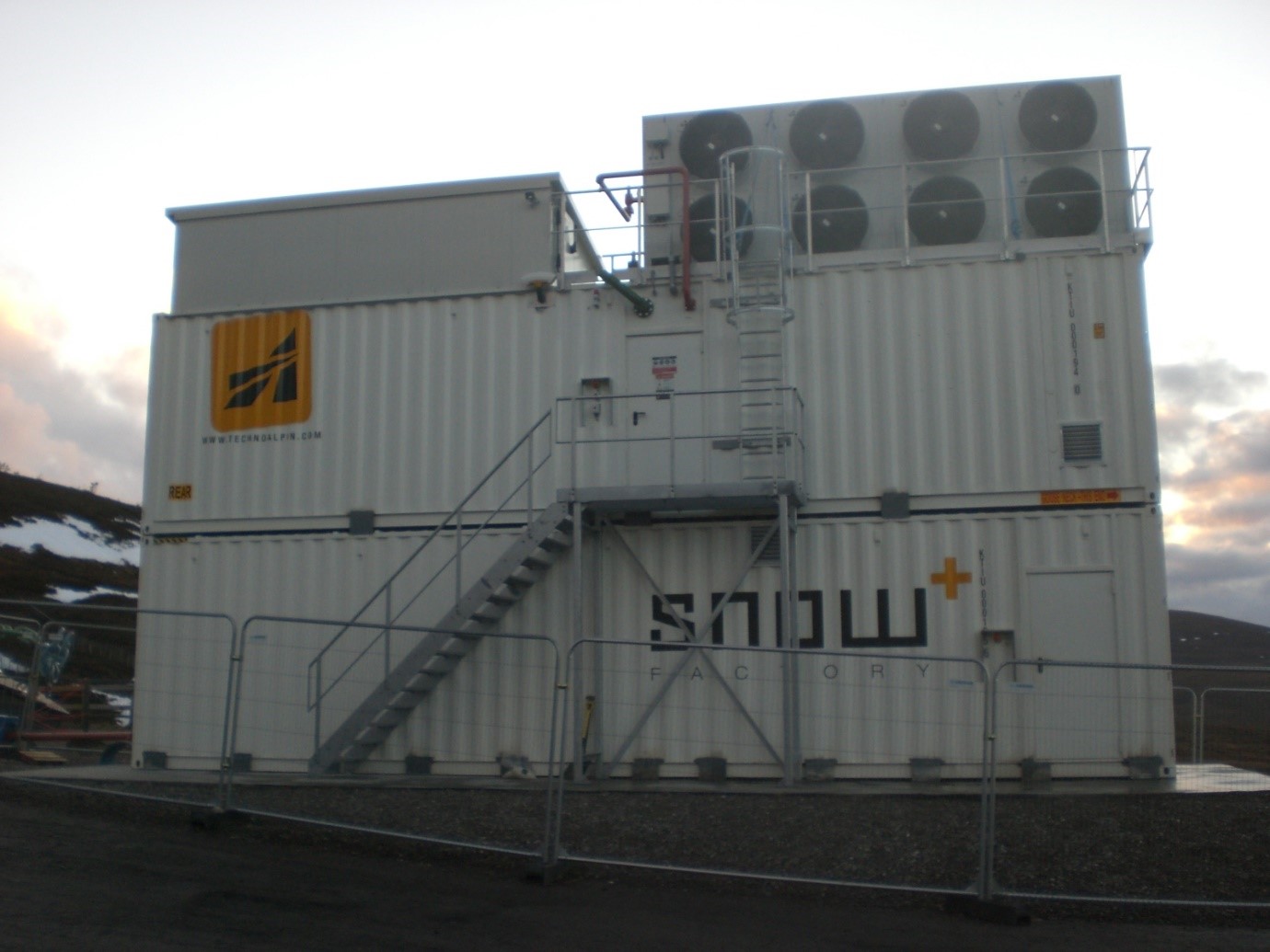
Following the failure of the Funicular Railway and the predictably adverse impact that this would have on the hill business and the wider local economy, Highlands and Islands Enterprise purchased a SnowFactory and 8 TR8 Snow Cannons from TechnoAlpin in an attempt to ensure at least some snowsports on CairnGorm, this winter. This post looks at what has been happening in the context of a very poor winter.
The costs of purchasing and running the snow factory – are these sustainable?
The Snowfactory cost 642,000 euros and the 8 TR8 Snow Cannons cost 363,841 euros. At today’s exchange rate that comes to £875,000. Additional costs of £7,050 were incurred to hire a crane to unload the equipment and lift the Snowfactory into place in the upper Coire Cas Carpark. Other known costs were: water settlement tanks at £4,240; a mobile fuel cube at £1,434; groundworks on the site for the snowfactory £29,184; and the supply of water works equipment £3,615. (All these costs were obtained through Freedom of Information requests)
HIE are paying to rent generators and purchasing diesel to power the Snowfactory as well as one generator/fuel cube for each of the snow cannons as can be seen in the picture.
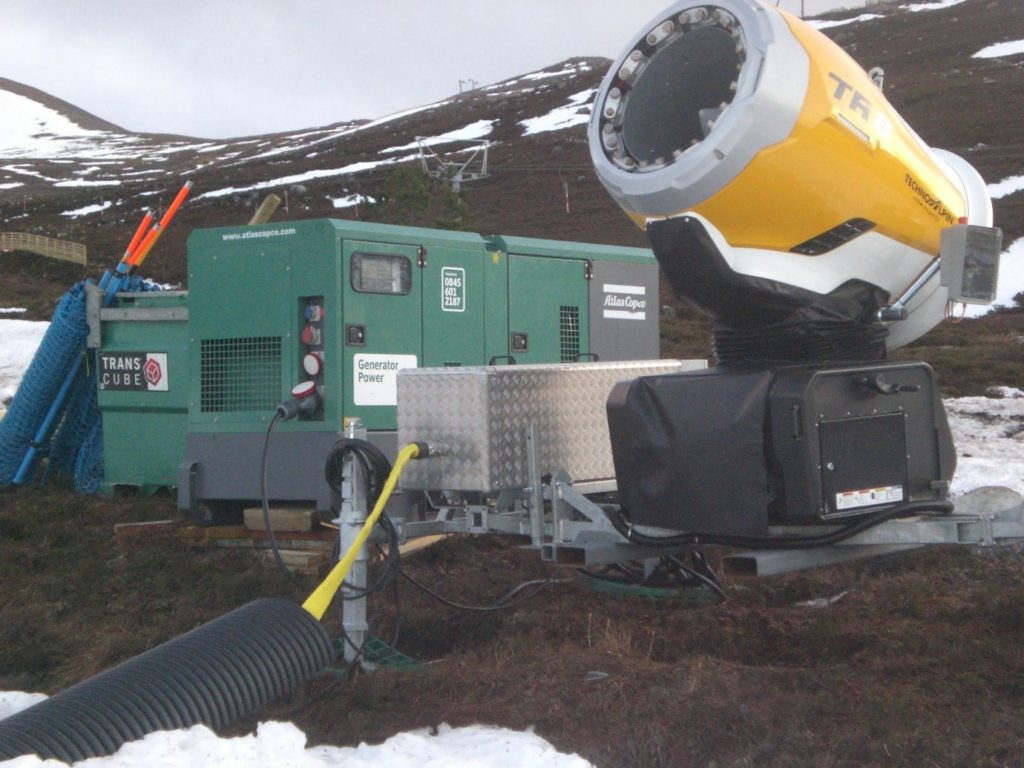
The total cost to the public purse will certainly be well in excess of the £1 million that was mentioned in HIE’s publicity. This very considerable expenditure should be closely analysed when the season is over so that future actions can be informed.
HIE were asked what the leasing costs to their new subsidiary, Cairngorm Mountain (Scotland) Ltd (CMSL), would be for the snowmaking equipment but they were unable to provide that information. It might reasonably be expected that CMSL will receive 40% grant funding which would be in keeping with the support given to the Lecht and Glencoe in respect of their purchases of Snowfactories. That would leave around £600k worth of equipment to be leased. A lease fee of around £75k per annum perhaps? These are very significant costs and they were made on the back of a less than successful snowmaking trial on CairnGorm last season
Following that trial, HIE commissioned a consultant’s report, this time into snowmaking. Hall Aitken, a Glasgow based consultancy produced a report that detailed the pros and cons of snowmaking at Lecht, Glencoe and Cairngorm (see here). The trial was reported as being inconclusive at Cairngorm where the operator, “Natural Retreats”, said that ‘further analysis was required’. Natural Retreats, at that time, had no intention of purchasing additional snowmaking equipment and they were focused on their misguided plans to build a Snowflex artificial ski slope. Perhaps that is why they were uninterested in snowmaking?
It’s quite clear that no private business or Community Enterprise could afford to pay the snowmaking costs that will have been incurred this season, particularly with no CMSL Ski school in operation to keep much of the revenue in-house. It’s something that will require very careful analysis going forward.
Making artificial snow using diesel powered generators is something that should not be a medium to longer term solution on Cairn Gorm. It was the only solution this year because there isn’t an adequate power supply to the hill. Quite apart from being very expensive, it isn’t environmentally friendly and SSE should be contracted to put in an upgraded supply. It’s believed that this would have to come from Inverdruie at an estimated cost of £2m of which CMSL would be required to contribute £400k. Of course, that sum would have to be publicly funded via HIE. HIE were asked when they planned to get this done but they could only say that it would form part of the new strategy that they were developing.
If Cairngorm Mountain Ltd/HIE had taken an open-minded approach to the development of run of river Hydro Schemes in both Coire na Ciste and Coire Cas then at least some of the power requirements, at the time of use, could have been provided in an environmentally friendly and sustainable way. When HIE were asked, in 2017, about the possibility of constructing hydro schemes in each Coire, they simply said that their tenant had not identified Hydro as part of their strategy. That was just another strategic mistake and everyone knows now how that all ended.
Cairngorm Mountain Ltd did engage a consultancy themselves long before Natural Retreats came to town and that report verified that Hydro development was very possible on the hill. John Duncanson Engineering produced a report in July 2012 that verified that Hydro development was quite feasible. If his report had been acted upon then a feed-in tariff of 18.5p per kWh would have been obtained. A 100 Kw Hydro Turbine operating at 50% capacity would have produced an income of £80,000 pounds per annum. By placing 100 kW Turbines In both Coire na Ciste and Coire Cas then the hill business would now be benefitting from £160,000 pounds of income each year as well as being able to use as much of the generated power as required, on the hill. Unfortunately nothing was done about this report. The hydrologists report, commissioned by the Save the Ciste campaign in 2015, was also dismissed. These missed opportunities have now led to a position where the hill business cannot take advantage of the Feed in Tariff scheme which ends in March 2019 and if Hydro schemes are now built then the feed-in tariff will be zero.
It isn’t difficult to see that the power being consumed by snowmaking could in fact have been cumulatively generated, in an environmentally and sustainable way. This exemplifies the closed-minded management that has contributed to the hill business failure, twice in the last decade.
Use of the snow factory and cannons this season
Spending circa £1m pounds on snowmaking equipment is very far from a panacea for all that ails the CairnGorm Mountain business. The problem has been made worse because the Snowfactory operation has not be as reliable as expected. In fact, there has been no skiing at all on CairnGorm for about two weeks due to technical difficulties with the Snowfactory operation. That’s in stark contrast to the situation at the Lecht Ski Centre where their snowfactory has operated continuously, without a hitch, since mid-November 2018 – despite the warm spell. The pictures taken on Friday 1 March tell the story
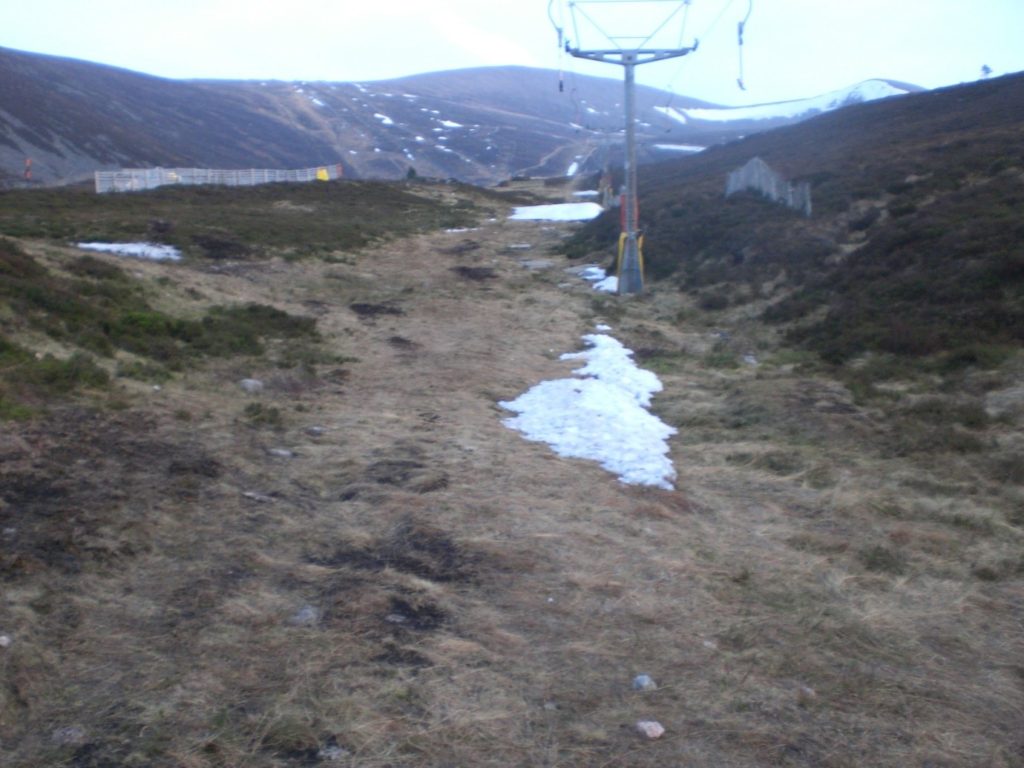
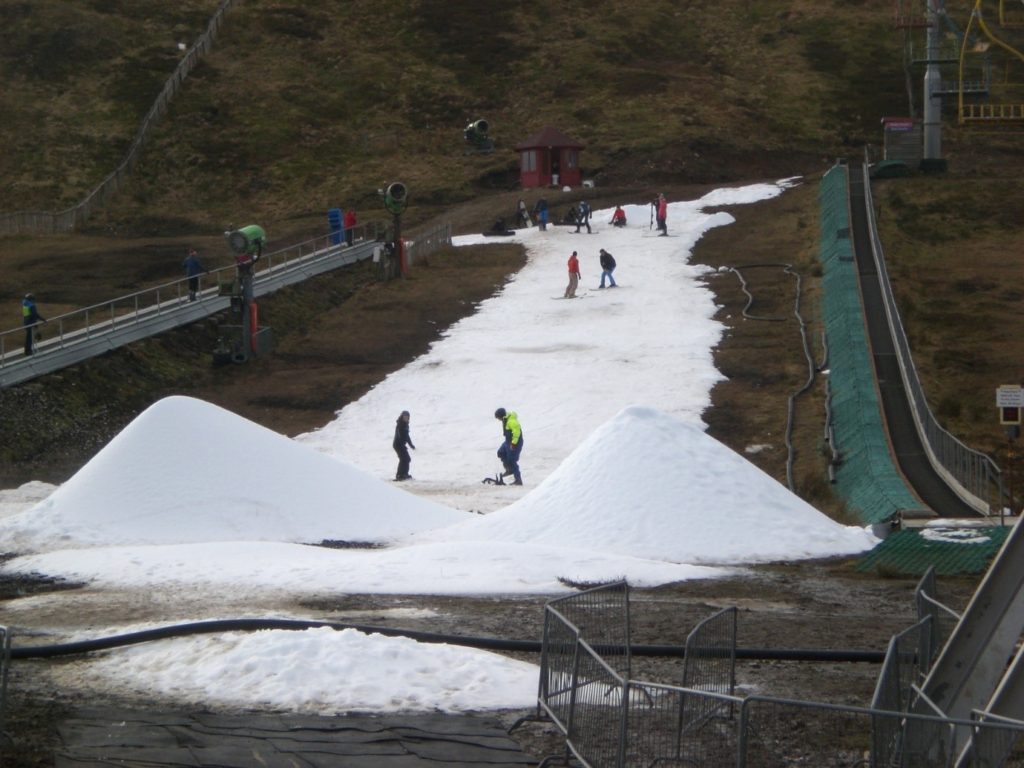
A solution to the problems besetting snowmaking at CairnGorm must be found soon. Perhaps they should draft in the professional expertise from the Lecht ski centre to sort it out?
The snowfactory has been located to provide snow on an area outside the Daylodge that is being used as a beginners area as well as covering the lower part of the Carpark T-Bar uptrack.
The snow cannons have been located at strategic points on a piste between mid-station and the Daylodge so that a continuous piste and tow uptrack may be possible on the lower part of the mountain. The picture, from a few weeks ago, demonstrates how after the natural snow had melted, the artificially generated snow was still there – for a time.

This season has shown very clearly that main considerations for snowmaking are that it should be made where ablation [melt] rates are lowest and where the least amount of snow can cover the greatest area. The sustained thaw last month fairly quickly broke up the complete piste from the top of the Carpark Tow to the Daylodge and also melted part of the T-Bar uptrack. As can be seen in the picture:
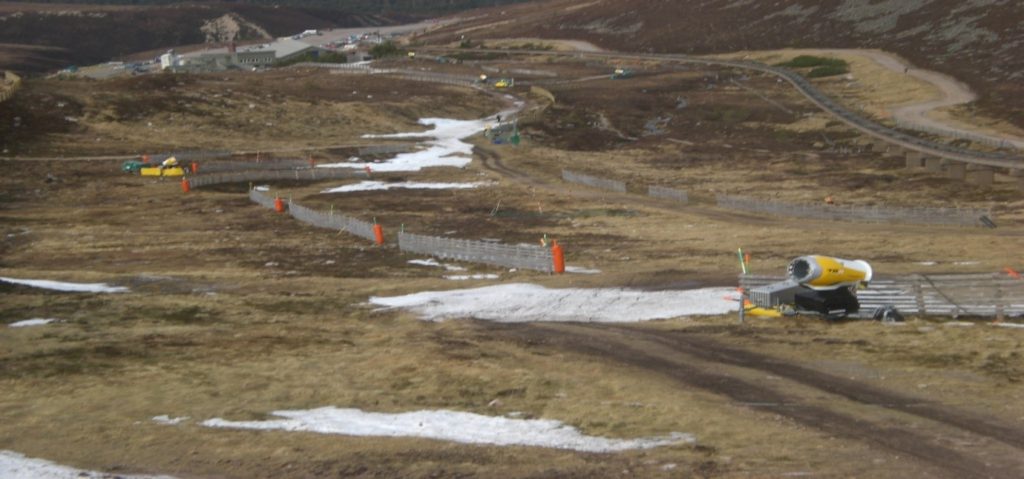 4
4
An open-minded analysis of the siting of snowmaking equipment should be undertaken as well as the revenues that can accrue from it and that should involve looking at different locations and not simply siting it where it is most convenient.
The lower Ciste, sheltered from the mild South Westerly winds by the steep sided Coire slopes, would be a much more suitable area because ablation rates would be significantly reduced and less snow could cover a larger area. In addition, this area with slope gradients between 0 and 6 degrees…steeper if required, on the west slope, is ideally suited for beginners and early learners and it would accommodate significantly higher numbers than outside the Daylodge in Coire Cas. An additional benefit would be the creation of a dedicated Sledgepark which is something that isn’t presently offered at Cairn Gorm. It would have the potential to bring in significant additional revenues just as it does at Glencoe.
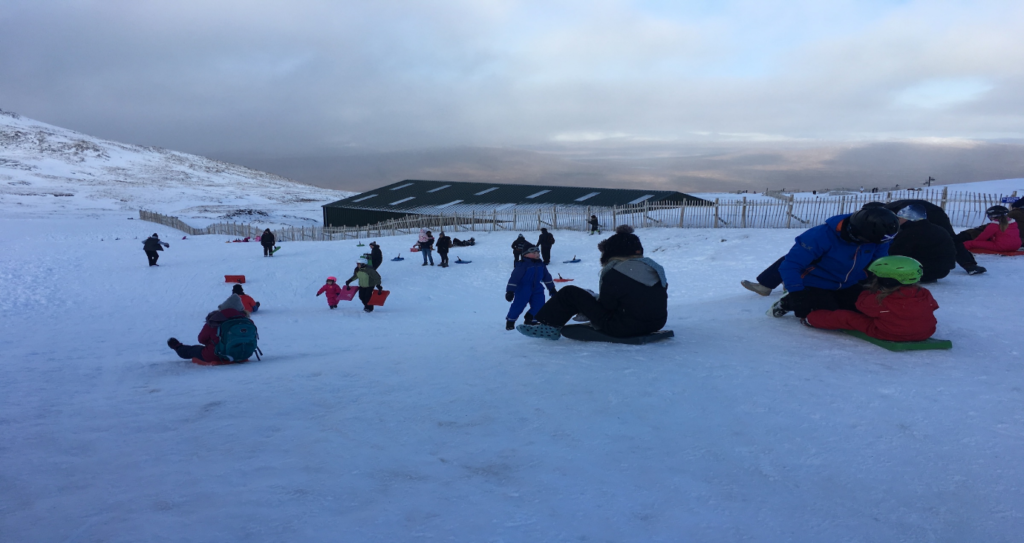
There are large numbers who take and pay for a Chairlift ride at Glencoe each season just to use the Sledgepark.
A sheltered Learning Zone and a magic carpet served Sledgepark could be a major winter attraction at Cairn Gorm and there is plenty of space to incorporate it all in the lower Ciste as can be seen from this picture
 6
6
It’s clear that if artificial snow is to play a meaningful role in the re-development of the CairnGorm Mountain business then some very careful analysis is going to have to be undertaken at the end of this season.
What has to happen now
HIE have to openly engage with all stakeholder groups as a way forward is sought. Local Snowsports schools, hill staff, the Aviemore and Glenmore Community Trust, the Aviemore Business Association, the Cairn Gorm Mountain Trust, the Save the Ciste Campaign, the Scottish and CairnGorm ski clubs ought all to be involved in determining how best to utilize over a £1 million worth of snowmaking equipment to the benefit of everyone.

Interesting article.
It does have to be said (and it has been said implicitly) that Cairngorm mountain has suffered massively from misfortune, lack of leadership and mismanagement.
I know how sensitive retrospective criticism is but things just have to learnt and built on.
The figures just don’t add up as a ski centre, never mind the lack of sustainable efforts in providing power and woeful reliability. The last turnover I saw for the whole cairngorm mountain was just over £2 1/2 m per year with 80 odd percent from the funicular. So, if the main asset is broken it needs fixed……
The consultants report was issued just after Christmas, it could easily have made into a repair scope of work that could have been tendered, contracts awarded and work planned to start early summer. With no noise constraints and good light the work could easily be double shifted and completed this summer.
What I’m interested in is where HIE are with this…….I fear no-where……..with a bit of determination and funding (there lies the rub………) it could easily be fixed and running again for the Autumn.
Hi Angus, what you say is quite right if the repairs are relatively minor but what happens if say 30 pillars have moved? The costs could be astronomical. That is why it is essential that HIE make public their engineering reports – they have refused to do so and there are appeals in under FOI. I also don’t think you are right to argue that the funicular has been the main money maker at Cairngorm – actually its good snow years that bring in the profit – and therefore it must be repaired. It begs the question why ski resorts like the Lecht has survived with far less public subsidy. The conclusion therefore surely needs to be that there needs to be a total re-think at Cairngorm but that will only happen if there is open and honest debate and engagement with all stakeholders. Nick
Skiing is not the future for cairngorm mountain as it does not provide a constant sustainable income.
The attraction has to be the mountain with a range of offerings.
Any scope of work coming from the consultants report will have a cost estimate with a range of estimates. The key decision will be if the cost of repair has a payback of circa 5-10 years which I guess will be very difficult. I see no possibility of any government providing any funding and there has been zero mention if it. Cairngorm mountain does not deserve any preferential treatment when compared to the other sites.
As a ski centre it isn’t sustainable……the vision has to be broader….